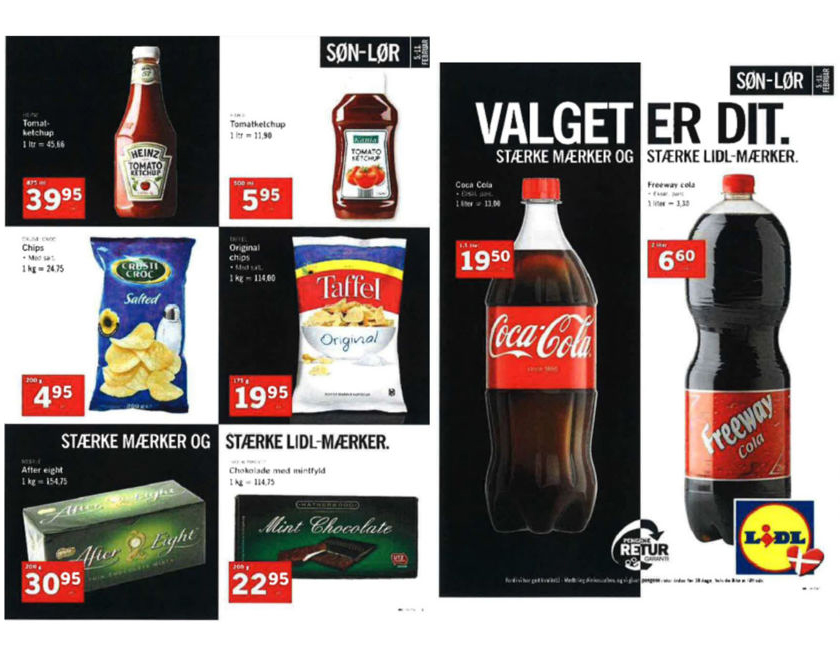When businesses advertise their goods by referring to competitive products, we call it a comparative advertising. The line between legal and illegal ads like these were marked in October this year when the Danish Maritime and Commercial Court assessed a case between Lidl and the Danish MLDK (Mærkevareleverandørerne).
The case revolves around a marketing campaign from 2017 in which Lidl uses the slogan “the choice is yours” (originally in Danish). The campaign shows a comparison between a list of well-known products and Lidl’s private-label products. Some examples are: NESQUICK compared to Lidl’s own GOODY CAO, CREMEFINE compared to Lidl’s MILBONA CREMOSANO and AFTER EIGHT chocolates compared to Lidl’s MINT CHOKOLATE.

Why did MLDK sue Lidl?
MLDK presented several problematic factors in Lidl’s campaign strategy that were to be considered in court including the fact that Lidl presented well-known brands on a black background and their own private-label products on a white background.
Besides, MLDK referred to Lidl’s choice of packaging, which has much in common with the well-known brands’ packaging. Some examples include the green colour on Lidl’s mint flavoured chocolates and the well-known AFTER EIGHT chocolates and the red colour on Lidl’s Freeway coke, which looks similar to the colour on a COCA COLA bottle. Additionally, MLDK asserted that the stated prices on the well-known brands were unwarranted.
What was the ruling?
First, The Danish Maritime and Commercial
Court assessed whether the campaign went against the rules for good marketing
practice. They considered whether the campaign could damage the reputation of
the well-known brands and whether it was deceptive.
Despite MLDK’s arguments, the court found no
reason to assume that Lidl marketed the well-known products in their stores for
the sole purpose of including them in the mentioned campaign.
Neither did the court find that:
- Lidl’s assigned prices on well-known brands were unwarranted
- Lidl had intentionally copied/imitated the well-known brands in order to use it in the campaign
- Lidl had placed well-known products and private-label products next to each other to infringe on the well-known products .
In other words, the court cleared Lidl for some of the accusations – but not all.
After an overall assessment, the court found that the well-known products had been used to increase the focus on Lidl’s affordable private-label products, which is an undue exploitation of the goodwill connected to the well-known brands. This means that Lidl’s campaign is against good marketing practice.
The ruling is based on:
- Lidl’s use of the slogan “the choice is yours” above every product comparison in the campaign
- Private-label products were marketed as parallel products to the well-known products
- The way that products were placed side-by-side in the campaign, which makes it likely that the well-known brands became a lever for the private-label products.
The ruling incl. more examples can be found here (in Danish) here.
What is the lesson?
The case shows that comparative advertising is legal as long as the comparisons do not result in one advertising being carried by the other – such as a private label relying on a well-known brand.
This case about comparative advertising does not cause any new standards for future disputes, which means that the main rules about objectivity, loyalty and fact-based marketing still apply.
Main rules for comparative campaigning:
- Compared products have to fulfill the same needs, meaning they should be exchangeable.
- The comparison has to be fact-based and based on similar criteria
- The sender of the campaign is obliged to respect the competitor’s brands and well-known characteristics.
The outcome of a trial will always depend on the individual case and circumstances. However, the case between Lidl and MLDK shows us that the law practice within this field is strict when firms incorporate well-known, competitive products in comprehensive campaigns.
This article was originally submitted as a comment in the Danish retail magazine ”Dansk Handelsblad”, on 15 November 2019.